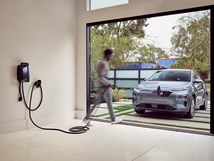Developer Touts 3D-Printed Batteries
Additive process promises to boost performance, speed production and lower costs
Switzerland-based Blackstone Resources is developing 3D-printed battery cells that the company claims are better performing and less expensive than conventionally manufactured units.
The company, which operates mines specializing in metals used in electric vehicle batteries, says it produced and tested the industry’s first 3D-printed functional cells last month. The technology is applicable to a wide range of chemistries and cell formats, including the mass production of next-generation solid state batteries, according to Blackstone.
Benefits
Current battery manufacturing uses highly specialized assembly processes. Production of the electrodes is time consuming, expensive, energy intense and involves toxic solvents.
In contrast, Blackstone describes its additive system as flexible and efficient. In the recent tests, the 3D-printed electrodes yielded as much as a 20% boost in energy density across common cathode chemistries.
The new process also enables a higher number of charging cycles. And the electrodes are created using water-based binder systems, which Blackstone says eliminates pollutants from the manufacturing process. Electrode calendaring also is no longer necessary as porosity can be designed directly into the printing process to further improve efficiencies.
What’s Next?
The next step is to launch series production of 3D-printed electrodes. To this end, Blackstone is evaluating potential manufacturing sites.
In addition to electrodes, Blackstone plans expand 3D-printing processes to other battery components and complete modules—including housings. This will further reduce costs, the company says.
Blackstone also has started testing 3D-printed solid-state batteries. Most carmakers and battery suppliers are developing solid state systems, which use glass in place of liquid electrolytes, promise significantly higher energy density, enhanced safety and faster-charging capability than current lithium-ion configurations.
Silicon Valley-based KeraCel also is developing solid-state batteries that can be produced via 3D-printing technology. Japan’s Musashi Seimitsu Industry made an unspecified investment in the company last year.
RELATED CONTENT
-
Increasing Use of Structural Adhesives in Automotive
Can you glue a car together? Frank Billotto of DuPont Transportation & Industrial discusses the major role structural adhesives can play in vehicle assembly.
-
Ford Copies Nature
As Nature (yes, capital N Nature) has done a pretty good job of designing things, it is somewhat surprising that Man (ditto) doesn’t follow Nature’s lead more often when it comes to designing objects.
-
Mustang Changes for 2018
On Tuesday Ford unveiled—using the social media channels of actor Dwayne Johnson (this has got to unnerve some of the auto buff book editors)—the 2018 Mustang, which has undergone some modifications: under the hood (the 3.7-liter V6 is giving way to a 2.3-liter EcoBoost four, and a 10-speed automatic is available), on the dash (a 12-inch, all-digital LCD screen is available for the dashboard), at the tires (12 wheel choices), on the chassis (MagneRide damper technology is being offered with the Mustang Performance Package), and on the exterior (three new paint colors). And while on the subject of the exterior, there are some notable changes—a lower, remodeled hood, repositioned hood vents, new upper and lower front grilles, LED front lights, revised LED taillamps, new rear bumper and fascia.








